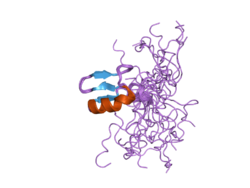Chromodomain-helicase-DNA-binding protein 7 is an ATP-dependent 'chromatin' or 'nucleosome' remodeling factor [5] that in humans is encoded by the CHD7 gene. [6] [7]
CHD7 is an ATP-dependent chromatin remodeler homologous to the Drosophila trithorax-group protein Kismet. [8] Mutations in CHD7 are associated with CHARGE syndrome. [9] This protein belongs to a larger group of ATP-dependent chromatin remodeling complexes, the CHD subfamily.






